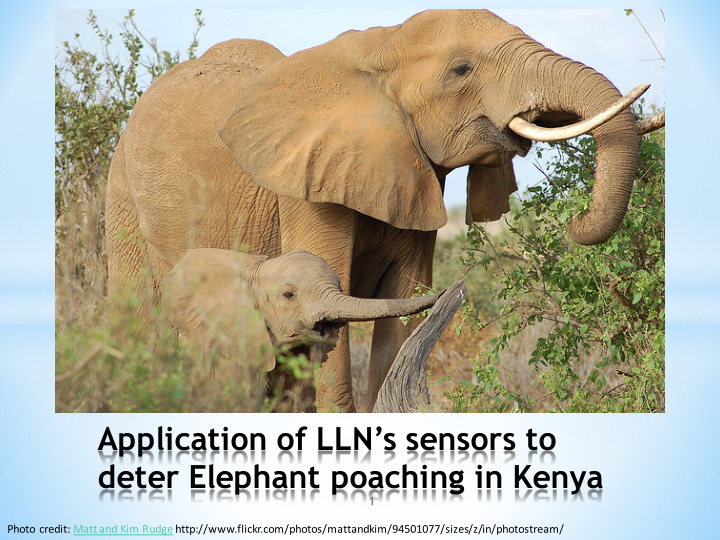



Application of LLN’s sensors to deter Elephant poaching in Kenya 1 Photo credit: Matt and Kim Rudge http://www.flickr.com/photos/mattandkim/94501077/sizes/z/in/photostream/
AGENDA * COUNTRY’S FAST FACT . * POACHING IN KENYA * CRISIS IN POACHING * CONSERVATION EFFORTS * GLOBAL EFFECTS * WHAT'S IS BEEN DONE * LLN’S OVER GPS USE * PROPOSED SOLUTION BASED ON LLN’S SENSORS * CHALLENGES 2
Size 582,650km ² Economic growth 5.4% (2015) GDP/capita ~US $ 1,588 Literacy 87% Doctors 0.13/1000 Life Expectancy 63 Population ~ 44 million Physical Location East Africa Tourism is 3 rd after Coffee Foreign Ex. and Tea https://www.gfmag.com/global-data/country-data/kenya-g dp-c ountry-report+&cd=1&hl=en&c t=clnk&gl=it - Last Updated Thursday, March 17, 2016 http://www.cnbcafrica.com /news/east-africa/2014/09/09/kenya-leads-internet/ - Last Updated: Tue, 09 Sep 2014 14:01:39 GMT http://www.bloomberg .com/news/articles/2015-03-05/world-bank -raises-kenya-s-economic-growth-forecast-to-6-percent - Last Updated 5th March 2015 3
● Threat to endangered and exceptional wildlife Populations. ● Elephants and black rhinos most common targets. ● Threat to the Kenyan Economy. ● National Security Implications. **Illegal hunting or trapping of wildlife for food or profit http://www.kenyalogy.com/eng /parques/parques.html
Kenya’s and East Africa’s Persistent Problem 5
"Our research which records the births and deaths of all elephants is a particularly sensitive barometer and alerted the world to what is happening with poaching. We reached a tipping point in 2009 where deaths outnumbered births.” By Dr. Iain Douglas- Hamilton 6 http://wildnet.org/wildlife-programs/elephant http://kron4.com/2014/08/18/poachers-kill-100k-elephants-in-africa/
7 http://www.itv.com/news/2016-03-14/the-decline-in-rhino-num bers/
GLOBAL EFFECTS * Developing countries demand for authority to sell ivory. * Boycott trade in ivory. * The global community must provide infrastructure to deter poaching. * Providing an alternative by creating economic opportunities. 8
* Demand for illegal ivory still very high. * Implement modern RTM of elephants * Decisive political will * Strenthening of communities and KWS * Enforce 1989 Ivory Trade Ban * Refrain from purchasing any items that may contain ivory. Kenyan President Uhuru Kenyatta boosts the international fight against poaching on Tuesday 3rd March 2015 – World wildlife day https://www.youtube.com/watch?v=J84nWN2lUGU 9
Social Responses Political Responses * Education! Wildlife = Tourism * Taking action from the highest = Income! office [1] * Social marketing to change * Stricter conservation policies and demand implementation * Stricter laws and enforcement Environmental Responses * NGOs (eg. WWF) and global Economic Responses organizations like CITES * Trade boycotts working on conservation. * Increased fines for poachers * GPS tracking devices on * More government spending on animals conservation and enforcement 10 [1] Kenyan President Uhuru Kenyatta boosts the international fight against poaching on Tuesday 3rd March 2015 – World wildlife day https://www.youtube.com/watch?v=J84nWN2lUGU
WHAT IS HAS BEING DONE? KWS and IFAW (International Fund for Animal Welfare ) using GPS collars to track the movement of elephants to protect them from poaching and learning about their migration patterns. The Tsavo East National Park region via the internet. 11 http://www.justgpstracking.com/blog/2011/03/gps-collars-prevent-elephant-poaching-in-kenya/#sthash.hLGcW6IC.dpuf Last Updated 24 March 2011
WHAT IS HAS BEING DONE? KWS and Amboseli Trust for Elephants (ATE) have continuously monitored the Amboseli elephant population. In 2002, researchers used the GPS points, satellite imagery, and Esri software to perform GIS analysis. ~35,000 Elephants 12 http://www.esri.com/esri-news/arcnews/summer15articles/mapping-a-future-for-kenyas-amboseli-elephants Last Updated 24 March 2011
WHAT IS HAS BEING DONE? This GPS collar sends an elephant's location information via satellite to security managers and park rangers. Save the Elephants (STE) specializes in elephant tracking through GPS 13 Last Updated 17 March 2015 http://africa.clintonfoundation.org/elephants/#!/
WHAT IS HAS BEING DONE? - Video Lewa wildlife conservancy rangers used the GPS points, satellite imagery , and mobile radios to keep track of the Elephants where bouts. https://www.youtube.com/watch?v=pSAkG27WM4E&feature=youtu.be Last Updated 24 March 2011 14
The use of LLN’s can be more favourable than GPS in that they are: * Require less power than GPS * Sensors are much smaller in physical size * More accurate in measurements .e.g on acceleration and temperature measurements. * Use IPv6 routing with inherent security. * Research to exploit open the possibility of ICN standards (Pursiut and NDN) or DTN especially for game reserves [community based]
PROPOSED SOLUTION BASED ON LLN’S SENSORS Mobile phone receives the triggered message that would require their action to visit the site The cloud storage service e.g. ubidots forwards the message to the mobile phone ranger in the field or command center VISUALIZE SEND Elephant in the park is fitted with a mote sensor an configured with an IPv6 address for internet routing READ A border router is configured to forward data from the mote to the cloud storage service. 16
PROPOSED SOLUTION BASED ON LLN’S SENSORS * Real-time monitoring (RTM) system to monitor the movement behavior of the elephants. * The tracking data are collected from the elephants and telemetered to a border router. * The sensor implements algorithms to measure (acceleration and temperature). * If an alert condition is detected, both an SMS message and e-mail are generated and issued to the border router. * The message is forwarded to the cloud storage e.g ubidots and is visualized by the mobile client of the rangers or at the command center. 17
* Limited computational power requires discreet use of cryptography. * Limited data rate requires careful co- ordination * Dynamic environment requires robustness to packet loss * Sensor design for the rugged wildlife terrain. * Sensor nodes may be inaccessible * Firmware needs to be updated for feature expansion or “bug fix”
Website: http://www.nacosti.go.ke Contact: +254 733 997 189 and cyrus.kamau@nacosti.go.ke
Recommend
More recommend